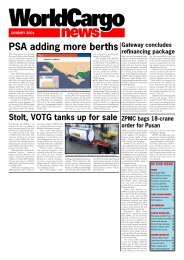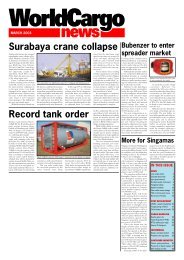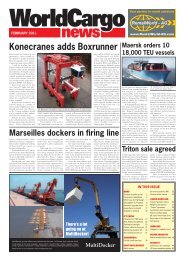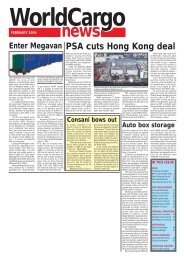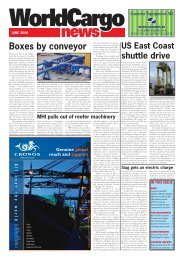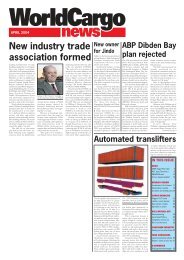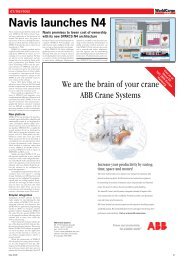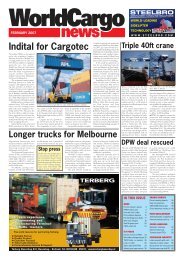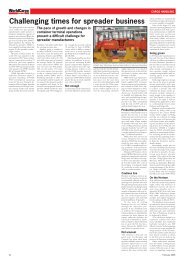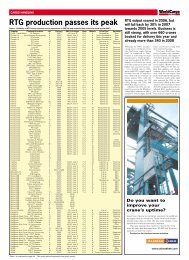WCN Dec Front page - WorldCargo News Online
WCN Dec Front page - WorldCargo News Online
WCN Dec Front page - WorldCargo News Online
Create successful ePaper yourself
Turn your PDF publications into a flip-book with our unique Google optimized e-Paper software.
CARGO HANDLING<strong>WorldCargo</strong>newsPatrick takes robotic routeNext year Patrick Stevedores willmove its Brisbane container operationsfrom berths 1-3 to berths7-9 as part of Brisbane Port Corporation’s(BPC) plan to relocatecargo activities from HamiltonWharves to Fisherman’s Island.After one year of commercialoperations with automated straddlecarriers (autostrads) at berth7, Patrick has declared the technologya success and it will extendthe operation over berths 7-9. Kalmar and Patrick are marketingthe technology to other operators,through Patrick Technologyand Systems (PTS), which isowned 85 per cent by Patrick and15 per cent by Kalmar.Patrick’s CEO Chris Corrigandescribes his company’s progresstowards automation as “careful andprogressive and not ideologicallydriven.”Following the 1998 waterfrontdispute (that Corriganterms a “period of reform”), portproductivity has improved significantlyand average net crane ratesnow exceed 25 moves per hour.Corrigan does not expect anotherbattle with the MaritimeUnion of Australia (MUA) whenit opens the new terminal. Patrickwill still operate a separate vehicleand general cargo terminal inBrisbane and Corrigan says therewill be few if any redundanciesfrom automation.The four keysBefore proceeding with theautostrad project, Patrick’s Boardneeded to be convinced that fourkey criteria would be met:● use of standard machines● flexibility (can be gradually implemented)● similar or better productivity● cost-effectiveness.As previously reported theautostrads are standard Kalmarmachines and the technology allowsautomation to be implementedin gradual steps. And, afterone year of operations at berth7 handling one call/week from aCosco vessel requiring 300-500container exchanges, Patrick is ina good position to evaluate productivityand cost-effectiveness.Berth 7 at Brisbane is nowsupporting a quay crane averageof 22 moves an hour, up from 15when the first vessels were handledjust over a year ago. By pushingCosco’s vessel quickly throughits calls at Melbourne and SydneyPatrick was able to buy extra timeat Brisbane in the early days whileit worked on improving productivity.Productivity is higher atPatrick’s Botany terminal (27.5moves/net crane hour) but theautostrads have hit the limit of thecranes at Brisbane.PTS’ technical directorGraeme Nelmes says hoisting andtrolley speeds are very slow andthe lift height (just above 20m)means the crane has to shuffleboxes once they are stacked 4-highon deck or gantry around a stackwith the hoisted box. Outreach issufficient for 13-row ships but listcan mean the ship has to be turnedaround to access the 13th row.Cost savingsPatrick calculates the autostradswill cut its labour costs at Brisbaneby 40 per cent and there arealso benefits from achieving a true24-hour operation. CurrentlyPatrick gets 21.5 hours workingtime from three shifts once mealbreaks, etc are deducted.Patrick also expects a 30 percent reduction in operating costsachieved through savings in paving,damage costs and fuel consumption.Autostrads need no linemarkings and stacks can be movedregularly by 0.5m so the terminalsurface wears evenly. Patrick isleasing berths 8 and 9 on an “unimproved”basis, meaning it mustpay for paving upkeep itself.By automating accelerationrates and speed Kalmar has beenable to cut fuel consumption by30 per cent and general maintenancecosts by 10-20 per cent. Inall, says Corrigan, the savings workout at around A$20/move at animp/ex terminal and, he expects,more at a transhipment terminal.Automation also means increasedsafety, although the MUATaking Botany lessonsPatrick expects to implementautostrads at Sydney, Melbourneand Fremantle, probably in thatorder. The current priority is toreconfigure the terminal at PortBotany to increase capacity from630,000 TEU to 1.3 mill TEU.This year Botany is expected tohandle around 560,000 TEU and,with a growth rate of seven percent, it will be full by 2005.Patrick has redesigned theBotany terminal to incorporate anew road/rail exchange area thatwill be served by up to sevenRMGs. By closing a public roadbehind the terminal Patrick willcreate room for RMGs with a15m cantilever for road trucks, a33.5m span for two rail tracks andintermediate stacking, and another15m cantilever for the straddle exchangewith the yard. The RMGswill be equipped with a rotatingtrolley and trucks will park underthe cantilever at a 45 deg angle.Patrick can achieve an averageutilisation of 80 per cent with fiveRMGs to begin with, but five arenot enough for the gate peaks. Toget round this a separate straddle/truck exchange area will be createdat the west end for out-ofgaugecargo.Importantly, the whole Botanyredevelopment is being plannedPatrick Stevedores will operate a 3-berth terminal inBrisbane with automated Kalmar straddle carriersProposed RMG layout for Patrick’sBotany terminalfor future automation. The RMGswill be semi-automated initially,with stacking between the legscontrolled automatically and theroad interface remotely by an operatorin a central location, similarto the OHBCs at Pasir Panjang,(although hand-held remote controllerswill also be available).No decision has yet been takenon when the autostrads will beimplemented but Patrick is clearthat it intends to take this route.Autostrads would increase the landarea available for container stacksas the machines are able to travelat full speed over stacks so fewerinternal roadways are needed.In the longer term Patrick canincrease capacity to 1.6 mill TEUwith 4-high straddle carriers andthese will be specified as the fleetis replaced. Looking even furtherahead, autostrads will be replacedgradually with RMGs and (automated?)shuttle carriers when furtheryard capacity is required. ❏says that on 13 October oneautostrad “went haywire” andcrashed through the fence into thereefer area. PTS’ principal consultantHoward Wren explains thatthe machine was having its controllerreplaced at the time. Theengineer failed to follow the correctprocedure and the autostradaccelerated forward into the fence.In Wren’s view, the incident actuallydemonstrated the efficacy ofthe safety systems. As soon as themachine moved the alarm was triggered,the brakes automatically appliedand it was halted within 3m.It is worth noting that in thesame month two separate incidentswith manned machines resultedin serious injuries to drivers.At Patrick’s Botany terminal adriver suffered a broken backwhen his machine overturned and,as reported on p2, there was also aserious accident in Auckland.New terminalWhen construction is completedon berths 8 and 9 Patrick will have750m of continuous berth and 25-ha of CY. None of the Brisbaneterminals have an intermodal interface,as the BPC’s policy is tooperate a common railhead forPatrick and P&O Ports. The exactnumber of quay cranes has notyet been decided but Patrick hasordered 14 3-high Kalmar e-driveautostrads purpose-built for automationwith no driver’s cabs.Two of the five existingautostrads will be kept and theother three will have their automatedsystems removed and bereturned to manual duty at PortBotany, bringing the robot fleet to16. Patrick’s total investment in thenew terminal is around A$100mill, depending on how manynew quay cranes are purchased.Nelmes says that Patrick’s reasonsfor switching to e-drive arethe same as at other straddle terminals;expected savings in maintenanceand fuel costs. The e-drivemachines will also bring significantbenefits for automation.Steering should be easier as thetorque converters on twin-enginehydrodynamic machines do notalways deliver exactly the samepower to both sides and electricmotors will allow for more precise,smoother inching control.The e-drive will provide fullhoisting power at any time. Currentlythe autostrads must stop andhoist the container after brakingin the turn to face the stack. Forthe engineers working on theproject, however, the most excitingpoint is the opportunity towork with brand new machinesinstead of ones battered from10,000 hours duty at Botany.At the moment the yard is laidout with stacks parallel to the quaybecause berth 7 was initially builtfor RTGs and the yard is longerthan it is deep. Berths 8 and 9 willhave a deeper yard and the stackswill run perpendicular to the quay.By 2009 berth 10 should be ready,giving the site a more uniformdepth, 850m of quay and a capacityof 850,000 TEU/year.The stacking system is a “controlledrandom” or “scattered” systembased on best available slotrather than stacking in vessel/weight bands. PTS managing directorChris Knott says this typeof yard management is easier toimplement in an automated environmentwhere route, accelerationand speed are known precisely.Currently two autostrads atBrisbane are devoted to the gateinterchange but at the new terminalall machines will be pooled.The development team is stilltweaking the yard system but Wrensays development is 97 per centcomplete. Braking is somewhatjerky but, adds Illka Annala,Kalmar’s VP, straddle carriers, thisproblem will go once the new controlsoftware has been bedded in.Patrick has not decidedwhether to refurbish existing cranes(some would have to be raised) orbuy new. Currently, the craneslower containers between the legswhere twistlocks are removed beforehoisting the container over thefence and into the automated area.Sydney: Kalmar’s CEO Christer Granskog and Patrick’s CEO Chris Corriganconfirm the deal for 14 purpose-built (cabless) autostrads with e-drive for BrisbaneNelmes was previously unconvincedby double trolley arrangements,but after visiting CTA inHamburg has changed his mind.However the decision may comedown to wheel loads - the quay isunable to support double trolleycranes weighing as much as theones at CTA from ZPMC.Patrick will probably opt for an18-wide outreach and a 50 tonneSWL. Add in a lighter structure, andit may be possible to keep withindock limits. Patrick’s own, patented6-fall reeving system and headblockdesign (<strong>WorldCargo</strong> <strong>News</strong>, <strong>Dec</strong>ember2002, p49) may also be fitted.Modular architecturePatrick and Kalmar have cut thecost of automation by developingmodular architecture that can be“bolted on” to existing systemswith minimal change in workprocedures. Only one machineneeds to be automated and any 5thor 6th generation Kalmar machinecan be used. The cost of theautostrads and the necessary hardwareand software has not beendisclosed, but Patrick says the premiumfor automation will pay foritself in less than 18 months.As noted, PTS is marketing thetechnology to the wider industry.For some time Kalmar has beenoffering Auto Pick and Place(APP) and Smartpath as an optionPatrick’s relationship withKalmar and Sydney University’sAustralian Centre for FieldRobotics has helped keep developmentcosts down (Knottestimates Patrick’s investmentin automation is less than A$30mill). Several graduate studentswho completed applied researchin port automation nowwork for the company. Fromnext year Patrick will fund aChair in automation and logisticsat the Centre. ❏on its CSC and e-drive machines.These systems use an array of sensorsto stop the straddle carrier inthe correct position over the container,lower and adjust the positionof the spreader and engage thetwistlocks. APP also controls thehoisting height for stacking operationsand Smartpath updates theTOS with container position everytime the twistlocks are activated.For navigation the autostradsare fitted with a dual-loop navigationsystem. The primary loopuses millimetre wave radar andsteer encoders whilst the secondis an inertial navigation systemcorrected by DGPS. (See <strong>WorldCargo</strong> <strong>News</strong>, May 2002, p51).The key control systems arethe traffic management system(TMS), the on-board vehiclemanagement system (VMS),which can interface with any vesselplanning software, and thenavigation system. There is also aweb-enabled remote maintenanceinterface. These systems are beingmarketed by PTS as licensed products.The third part of the automationpackage is the expertise todesign the layout and implementthe technology and PTS offers thison a consultancy basis.Needless to say there is muchinterest in the terminal. Peoplefrom every major global terminaloperator have visited the site. Wrenis preparing several layouts for interestedoperators but no doubtmany are waiting to see a fullmulti-user terminal operating ona larger scale before committing.Patrick is confident that automationwill give it an edge in theAustralian market and it could alsobe a competitive edge for Patrickto expand outside Australia.Corrigan, however, playeddown the suggestion. “Our primaryfocus” he said, “is getting thetechnology to work in the Australianenvironment.” ❏<strong>Dec</strong>ember 2003 21



